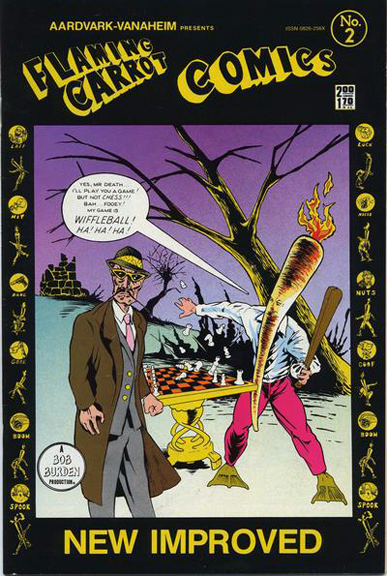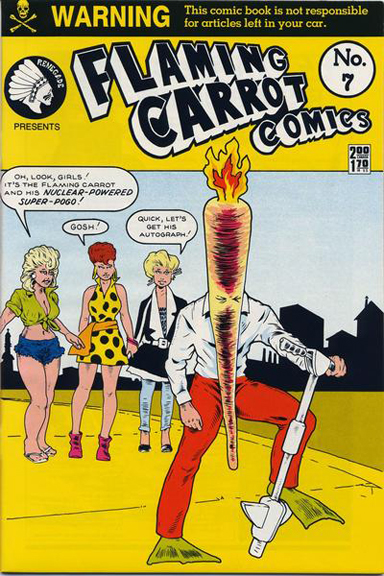For Your Consideration: Dark Horse’s Flaming Carrot Comics Omnibus Vol. 1
by Robert Greenberger
The birth of independent comics was stretched throughout the 1970s, arguably beginning with Jack Katz’s First Kingdom and ending with the arrival of Flaming Carrot in 1979, just before independent comics publishers took off. While attention has been justly paid to Katz, Richard and Wendy Pini, and Dave Sim, Bob Burden tends to be overlooked.
Burden may have been born in Buffalo, New York, but is closely associated with Atlanta since 1976. With a degree in Journalism, he has always considered himself first and foremost a writer. That he also illustrates most of his work is considered incidental.
He created his titular character, the Flaming Carrot, as one-off story for Visions, a publication from the 1979 Atlanta Fantasy Fair, a forerunner to the better known DragonCon. The story struck a chord so he continued producing stories for the con, through 1987. At the same time, he set up his own Killian Barracks Press and released the oversized Flaming Carrot Comics. Ever since, Burden’s character has appeared in quite a few places before settling in at Dark Horse Comics. He’s even crossed over with the Teenage Mutant Ninja Turtles in addition to making cameos in a dozen or more other titles.
Most of this material has been out of print for ages, making the Carrot an almost forgotten character. That gets rectified in October when Dark Horse releases Flaming Carrot Comics Omnibus Vol. 1, collecting Flaming Carrot #1-2, 4-11, 25-27.
Burden is a great conversationalist and I miss our annual casual meetups at various conventions. He’s friendly and funny and just terribly interesting. How else can you explain that Bill Everett’s Golden Age hero the Fin was the character’s inspiration?
In 1985, the character’s origin was explained this way: “having read 5,000 comics in a single sitting to win a bet, this poor man suffered brain damage and appeared directly thereafter as—the Flaming Carrot!” Much as Don Quixote/Alonso Quijano read too many romantic adventure stories; Burden used this poke at fanboys to create a surrealistic hero that works as a meta commentary at fandom though the years.
His verbal calling card is “Ut!” which Burden explained was something George Harrison shouted during a Beatles performance at Shea Stadium. The word stuck with him for over a decade before he could find a proper home for it.
The whimsical, satiric stories are set in the Palookaville section of Iron City where oddities happen with tremendous regularity. There are dangers everywhere you turn, such as a toxic waste pit (where the Carrot once died – yes, he got better) so you have to be careful.
This poor wretch crafted his own outfit complete with the giant carrot head piece with the button-down white shirt, red pants and flippers. His version of a utility belt comes complete with oddities including Silly Putty, rubber bands, random playing cards, and sneezing powder. Burden always finds an imaginative use for these as the Carrot stops alien invasions, Communist incursions, flying dead dogs, the Man in the Moon, and Death.
The headpiece is a technological marvel, with its eternal flame at the top and durable enough to store a nuclear-powered pogo stick. Both head piece and stick were crafted by Dr. Heller of Iron City’s Mystery Men (who you may vaguely recall was a movie starring William H. Macy and others; the Carrot was not in the film).
He can also place himself into a state of “Zen Stupidity” to better prepare him for his quixotic war on crime.
If you try and take this stuff seriously, it will merely hurt your head. The PR for this collection points out this sort of meta-hero precedes Deadpool and has a twisted view of reality long before we first visited Twin Peaks.
There’s a reason the series won the 2007 Eisner for Best Humor Publication (after being nominated in this category in 1992 as well as that year’s Best Continuing Series). His efforts have been recognized through the years with the Inkpot Award, the ACE Award, the Ignatz Award and several Kirby Award nominations.





USER COMMENTS
We'd love to hear from you, feel free to add to the discussion!